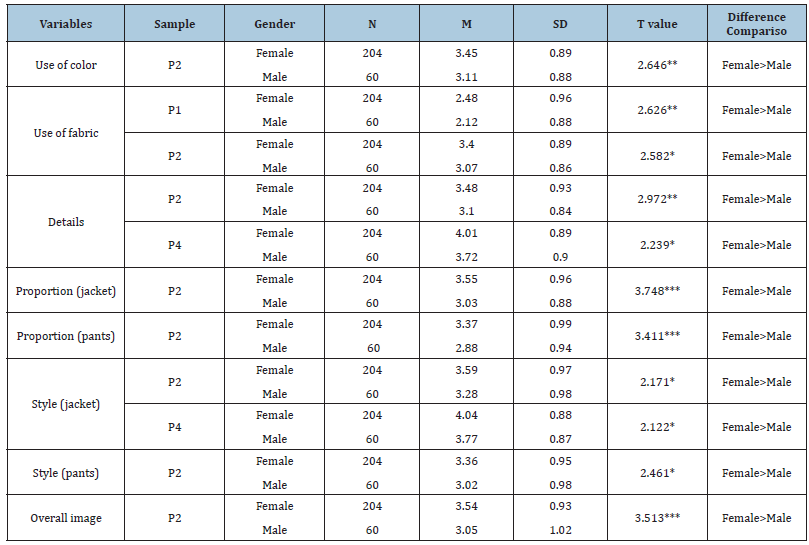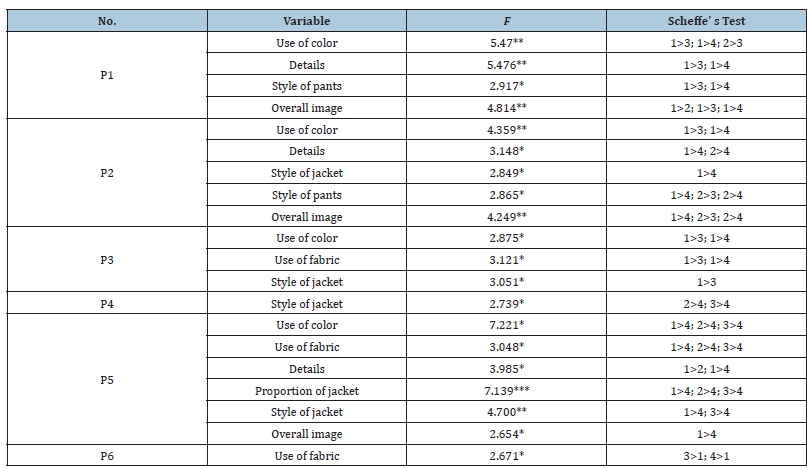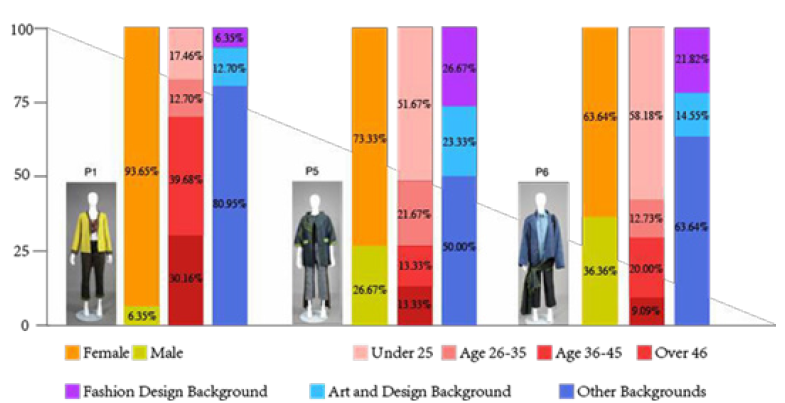- Submissions

Full Text
Trends in Textile Engineering & Fashion Technology
Gender Expression in Fashion: A Case Study of Perception in Clothing
Chien-Chih NI1,3, Yanru Lyu2 and Rungtai Lin3*
1Department of Fashion Design, Hsuan Chuang University, Taiwan
2Department of Digital Media Design, Beijing Technology and Business University, China
3Graduate School of Creative Industry Design, National Taiwan University of Arts, Taiwan
*Corresponding author:Rungtai Lin, Graduate School of Creative Industry Design, National Taiwan University of Arts, No. 59, Section 1, Daguan Road, Banqiao District, New Taipei City, Taiwan
Submission: June 23, 2021; Published: July 20, 2021

ISSN 2578-0271 Volume 6 Issue 3
Abstract
Gender expression in fashion has been increasingly role in the individual expression of style and taste. However, people’s demand for clothing coding does not reflect the physiological attributes but also meets the psychological pleasure. This research discusses the gender perception of subjects with different gender, ages, and majors through six sets of garments representing three styles. The questionnaires were used to obtain data from 264 subjects. The results showed a significant difference among the perception of female, male, and genderless styles. Findings revealed that female and young people could feel a higher degree of masculinity in clothing coding than men. In addition, fashion designers’ perception of female coding is higher than other backgrounds. Based on young people’s high preference for genderless coding, the unisex style should be further explored to meet the needs of this group. Results presented herein provide designers with a valuable reference for coding the form in fashion to match the needs of gender expression from different consumers more accurately.
Keywords:Perception; Gender expression; Fashion design; Genderless
Introduction
Increasingly, there is a multitude of fashion products affording individuals an expression
of style and taste, which gradually blurred the boundary of gender. Indeed, the function of
garments has progressed from support an outward expression of gender-based identity to
meet personal-psychological pleasure. Such a phenomenon is emerging traditionally feminine
design elements in men’s suits and coins a new term: ‘neo-crosssexual’ [1]. In addition, unisex
clothing as worn by both males and females appears to be one of the latest fashion trends [2].
It should be noted that other external and social factors further influence gender dress. The
vital issue would understand both designer and consumers’ insight into gender coding. This
study aims to explore fashion design trends by evaluating the perception of gender expression
in clothing.
The contribution of this work is essential to clarify the aspects as following:
A. Different perception to gender information of dress by subjects with different
gender, ages and majors.
B. Preference between male and female for clothing style.
Literature Review
Fashion serves two apparently contradictory purposes, distinction, and generalization [3]. Clothes come in close contact with an individual’s body, and they also play a part in defining roles in society [4,5], while its cultural meanings become a metaphor for gender [6,7]. The composite cultural structure provides many opportunities to display individual and social traits and allows them to showcase various qualities that they are influenced by, including gender, style, race, sex, one’s sense of belonging, and transgression toward society [8]. The diffusion of fashion has become more challenging to study because fashion has become less centralized [9].
Fashion was not always a gendered phenomenon until the 18th century. At the end of the 19th century, bourgeois men refrained from using all forms of decoration, gayer colorful fabrics, and jewelry, leaving it all to women [9]. However, menswear is consciously incorporated with feminine design elements in men’s fashion today [1]. Women also use fashion as a powerful tool for the reversal of traditional gender roles. Such as pants for women began to just in sports and some limited activities and then become more and more popular without being criticized [10]. The gender difference that fashion communicates would then begin to become stronger than the difference in social class [9]. Some branding of unisex or genderless, such as J.W. Anderson, offers a modern interpretation of masculinity and femininity [3]. Gender in fashion as an un-fixed concept is always open to change, so it is necessary to provide timely insight into society’s development.
Design elements influence the appearance of a piece of garment, which was summarized as colors, silhouette (lines and contours), material, and proportion [11,12]. The color of clothing produces a strong effect on sensory perception and appears profoundly symbolic and expressive; the lines of clothing generate visual effects of movement and energy; shapes have the potential for form, expression, and symbolism. The subjective influence of clothing, such as people choose color, style, and proportion of garments, is according to their social status, role, and age [6]. Forecasters, generally consulting fabric designers, predicted colors and fabrics a few years before a particular style is marketed [9]. However, fashion is more a product to meet psychological pleasure today, which needs a human-centered approach to design. Therefore, this research aims to provide a reference for the designer to match needs by evaluating the perceived effect of subjects to design elements.
Material and Methods
Materials
This study evaluated garments designed by students with an educational background in fashion design. They were asked to combine different colors, materials, and proportions to create 24 sets that reflect male, female, or genderless. In order to maintain the consistency of the evaluation, each project has a jacket and a pair of trousers. This study selects six sets with more accurate coding as samples, which are illustrated in Figure 1. Among them, P1 and P3 use some elements to reflect the female gender, while P4 and P6 show the feeling of males. Unlike the formers, P2 and P5 try to mix the design elements to blur the gender, as shown in Table 1.
Figure 1:The six clothing of this study.

Table 1:Design elements of the six samples.

Participants
The research involved two hundred and sixty-four participants (60 male and 204 female). There were 51 participants with a background in fashion design, 39 participants with a background in art and design, and 174 participants belong to other professions. In terms of the age distribution, 108 subjects were under 25 years of age, 43 subjects were between 26 and 35, 62 subjects were between 36 and 45 years of age, and 51 subjects were over 46 years old.
Methods
The dependent variables in this study are presented in the questionnaire on the participants’ perceptions. The first part is the basic information, including gender, age, and educational background; the second part is a questionnaire on the six sets of clothing. The options of design elements include “Color collocation,” “Details,” “Fabric application,” “Proportion (jacket),” “Proportion (pants),” as well as the overall feeling of “Style of jacket,” “Style of pants,” “Overall image.” Each question was be evaluated from 1 point (highest level of femininity) to 5 points (highest level of masculinity). The third part was to select the favorite sample from among these six and indicate its number. This study adopted an online questionnaire and a total of 322 questionnaires were collected. After removing 58 invalid questionnaires, 264 valid questionnaires were collected for further statistical analysis. Descriptive statistics, independent sample t-test, one-way ANOVA and Chi-Square test were conducted to explore subjects’ perceptions of the gender expression in the six sets of samples.
Results and Discussion
Descriptive statistics analysis
According to the average score results as shown in Table 2, P1 and P3 are closer to the perception of females, while P4 and P6 can be perceived as a more male image than others. This result indicates that the critical design elements of female clothing involve bright color, soft fabric, vivid pattern, the short proportion of jacket, skinny proportion of pants. In order to reflect the feeling of males, it should be paid attention to the color representing men (such as blue), coarse-textured fabric, splicing, the loose proportion of jackets and pants.
Table 2:Results of descriptive statistics.

In addition, the result demonstrates that there is consistency between the subject’s gender perception and the designer’s gender expression in fashion design. Bright colors, smooth materials and decorative patterns of the top, and slim pants are easier to convey women’s perception. Unlike it, the jacket pasted up with rough blue fiber and loose pants is more masculine. As for the unisex style, the design elements include stripes pattern, loose proportion, and color block, which do not have apparent gender tendency.
Difference analysis of perceptive effects according to gender
An independent sample t-test was used to analyze the differences of perception between different genders, and the data are sorted, as shown in Table 3. There are significant differences mainly focused on the samples of P2 and P4. As for the clothing without clear gender information, P2 was perceived by females as more masculine than by males. It indicates that there are differences between men and women in the perception of unisex design, in which women can perceive more male’s feeling from the neutral elements in the designer’s eyes than man. In addition, female subjects got a higher level of masculinity in cotton material of P1 than males. There are significant differences in the perception of detail and jacket style of P4 between males and females, as those women are easier to feel masculine than men.
Table 3:Differences in perception of different gender.

*p < 0.05, **p < 0.01, ***p < 0.001
Difference analysis of perception effects according to age
For exploring the differences between age groups, eight assessment factors were taken as dependent variables, with age as the independent variable. One-way ANOVA was adapted, and the results were shown in Table 4. According to the results of Scheffe’s test, the younger the subjects were, the more masculine they felt about the sample from P1 to P5. In contrast, P6 as the sample of male style has the opposite sensing result. Young people under 25 are more challenging to perceive masculinity than those aged over 36 to fabric liking denim. The result indicates that gender expression is influenced by the development of the times, resulting in significant differences in the perception of groups of different ages.
Table 4:Differences in perception of different age.

*p < 0.05, **p < 0.01, ***p < 0.001 (1 = under 25, 2 = age 26-35, 3 = age 36-45, 4= over 46)
Difference analysis of perception effects according to majors
Table 5:Differences in perception of different majors.

*p < 0.05, **p < 0.01 (1 = Fashion Design Background, 2 = Art and Design Background, 3 = Other Backgrounds)
One-way ANOVA was used to analyze cognition differences with different majors, and these data are sorted, as shown in Table 5. Table 5 shows significant perceptual differences between the group with fashion design backgrounds and people with other backgrounds. For the female dress such as P1 and P3, professionals felt more masculine. On the contrary, they perceived more feminine than others in the male samples of P4 and P6. This means that fashion designers have particularly sensitive to gender perception, which was the power of innovation. Evidently, fashion designers pursue gender expanded, such as ingenious cut-of suits with short for expressing a new image of masculine sensuality [13].
Three favorite clothing
To further determine whether the participants’ preference for clothing varied in different gender, ages and majors, a Chi-Square test was used to analyze the three favorite samples. The top three dresses were P1(23.86%), P5(22.73%) and P6(20.83%). Figure 2 shows the proportion of people with different gender, ages and majors selecting the three samples. According to the results, the proportion of female subjects choosing P1 was significantly higher than the average 77.27%, which indicates that women have a better acceptance of coding elements of P1. In the selection by different age, the group under 25 have more subjects like P6, over the average 40.91%, and the people aged 25 to 35 have a higher proportion than average 16.2% to choose P5. While more older people over 36 prefer P1. Matching with younger the subjects have a higher acceptance of masculine elements. They more like the male and genderless styles, such as P5 and P6. As for the differences in major, the groups with fashion or art design backgrounds are favorite of P5, whereas the number of other backgrounds to choose P1 is higher than average. The results indicate that designers are more receptive to unisex.
Figure 2:Proportion of the three most favorite samples.

Conclusion
The research explored the perception effect of different gender, ages, and majors on gender expression in clothing. According to the experiment results, there were significant differences in perception among them. Women can feel a higher degree of masculinity in clothing coding than men, and young people are more sensitive than old. Besides, the group with fashion background is more sensitive to feminine fashion than to masculine, which is reflected in that fashion designers’ perception of female coding is higher than other backgrounds, while their perception of male coding is weaker. Regarding the participants’ favorite sample, the results show that most women prefer clothes with female elements, but men do not show significant differences in the three styles. Based on young people’s high preference for genderless coding, the unisex style should be further explored to meet the needs of this group. Furthermore, groups with design backgrounds and other majors have a favorite of different fashion styles, so they need to be analyzed separately.
This study had several limitations. Firstly, the clothing samples in this study were all designed by students. If the works of other professionals are included, there may be differences in the use of design elements, and the perception effect may also be different from this study. The second limitation was that female subjects were much more than male and focused on a geographical area. In the future, the research team will evaluate the experience of males and diverse groups with different regions and cultural backgrounds to understand further the differences in gender perception of fashion between different subjects.
References
- Lee HR, Kim J, Ha J (2020) Neo-Crosssexual fashion in contemporary men’s suits. Fashion and textiles 7: 1-28.
- Bardey A, Achumba W, Chiu P (2020) Exploring the third gender in fashion: From consumers’ behavior to designers’ Approach towards unisex clothing. Fashion Practice 12: 421-439.
- Reis B, Miguel R, Jerónimo N, Pereira M, Azevedo S (2018) Analysis of attributes in unisex and genderless clothing: Reverse Design. CRC Press, USA, pp. 87-93.
- James W, Burkhardt F, Bowers F, Skrupskelis IK (1890) The principles of psychology, Macmillan London.
- Crane D (2012) Fashion and its social agendas: Class, gender, and identity in clothing, University of Chicago Press, USA.
- Arvanitidou Z, Gasouka M (2013) Construction of gender through fashion and dressing. Mediterranean Journal of Social Sciences. 4(11): 111.
- Kaiser S (2014) Gendering fashion, fashioning gender: beyond binaries. Fashion and Cultural Studies, pp. 121-170.
- Calefato P (2004) The clothed body, Berg Publishers, UK.
- Kawamura Y (2005) Fashion-ology: an introduction to fashion studies, Berg Publishers, UK.
- Sawyer CH (1987) Men in skirts and women in trousers, from Achilles to Victoria Grant: one explanation of a comedic paradox. Journal of Popular Culture 21(2): 1-18.
- Han SB, Lee YH (2012) Characteristics of gender-bending design in contemporary men's dress shirts. Journal of The Korea Fashion and Costume Design Association 14(2): 157-169.
- Bowstead JM (2018) Menswear revolution: The transformation of contemporary men’s fashion, Bloomsbury Publishing, UK.
- https://www.vogue.com/article/menswear-summer-2018-trend-short-shorts.
© 2021 Rungtai Lin. This is an open access article distributed under the terms of the Creative Commons Attribution License , which permits unrestricted use, distribution, and build upon your work non-commercially.
 a Creative Commons Attribution 4.0 International License. Based on a work at www.crimsonpublishers.com.
Best viewed in
a Creative Commons Attribution 4.0 International License. Based on a work at www.crimsonpublishers.com.
Best viewed in 







.jpg)






























 Editorial Board Registrations
Editorial Board Registrations Submit your Article
Submit your Article Refer a Friend
Refer a Friend Advertise With Us
Advertise With Us
.jpg)






.jpg)














.bmp)
.jpg)
.png)
.jpg)










.jpg)






.png)

.png)



.png)






